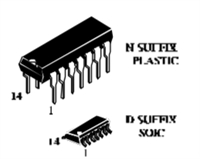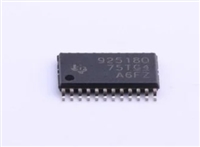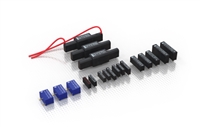THE CONNOR-WINFIELD CORP.
Stratum 3 Simplified Control
Timing Modules (MSTM-S3-T2-FD)
Fig. 1.0
DESCRIPTION
The Connor-Winfield Stratum 3 Miniature Simplified
Control Timing Module acts as a complete system clock module for
general Stratum 3 timing applications. The MSTM is designed for
external control functions. Full external control input allows for
selections and monitoring of any of four possible operating states: 1)
Holdover, 2) External Reference #1, 3) External Reference #2, and 4)
Free Run. The table below illustrates the control signal inputs and
corresponding operational states:
In the absence of External Control Inputs (A,B), the MSTM
enters the Free Run mode and signals an External Alarm. The
MSTM will enter other operating modes upon application of a proper
control signal. Mode 1 operation (A=1, B=0) results in an output
signal that is phase locked to the External Reference Input #1. Mode
2 operation (A=0, B=1) results in an output signal that is phase
locked to External Reference Input #2. Holdover mode operation
(A=1, B=1) results in an output signal at or near the frequency as
determined by the latest (last) locked-signal input values and the
holdover performance of the MSTM.
MSTM-S3-T2-FD
PIN ASSIGNMENT
S0
S1
+5Vdc
EX REF 1
GND
EX REF 2
GND
VALID_R1
VALID_R2
GND
CLK_OUT
GND
CNTL A
CNTL B
A1
SYNC_OUT
GND
BOTTOM VIEW
Fig. 2.0
The primary feature of this model is the Reference
Frequency Detector (RFD). This is an independent circuit that
monitors both reference inputs simultaneously to determine that a
signal is present and its frequency is within a valid range. A logical
one on the outputs VALID_R1 and VALID_R2 indicates that the
signals applied to EX_REF1 and EX_REF2 respectively have been
detected and have a frequency that is within at least +/- 4.6 ppm of
nominal. A range of +/-4.6 ppm is guaranteed for the life of the
module. The actual range is somewhat more than twice that to
account for normal drift and aging that will occur. When, for
example, the reference applied to EX_REF1 disappears, VALID_R1
will go to a logical zero within 500 microseconds. When the signal
returns at a frequency within +/- 4.6 ppm of nominal the VALID_R1
output will return to a logical one after a 4-second delay. The delay
is a validation period that requires the output of the frequency
detector to remain stable for 4 seconds before confirming the status
of the reference applied. This eliminates the incessant toggling of
the frequency detector that occurs when the reference frequency is at
the threshold frequency of the detector
BLOCK DIAGRAM
CNTL A
CNTL B
0
1
S0
S1
TCXO
R1-CHK
EX REF 1
VALID_R1
EX REF 2
R2-CHK
The function of the RFD is not related to the operational alarms,
LOL and TVL, which monitor the operation of the PLL relative to
the selected active reference. In fact the operational alarms function
only at the extreme edge of the PLL operating range. This means that it is quite possible for the active reference to drift out of range of the Reference
Frequency Detector and still remain well within the capture range of the PLL and not activate the operational alarms. If the other reference was still
marked valid by the RFD it might make sense to switch to the better reference before the selected reference drifts completely out of range.
Alarm signals are generated at the Alarm Output during Holdover and Free Run operation. Alarm Signals are also generated by loss-of-lock,
loss of Reference, and by a Tune-Limit indication from the PLL. A Tune-Limit alarm signal indicates that the OCXO tuning voltage is approaching
within 10% the limits of its lock capability and that the External Reference Input may be erroneous. A high level indicates an alarm condition. Real-
time indication of the operational mode is available from outputs S0 and S1, which are determined from internal mode registers.
Control loop filters effectively attenuate any reference jitter and smooth out phase transients.
Specifications are subject to change without notice
DATA SHEET #: tm023
REV. A02
FILENAME: MSTMS3T2FD.DOC
DATE: 10/24/01
Page 1 of 8
Copyright 2001 Connor-Winfield all rights reserved











 SL74HC10N:高性能三输入与非门解析
SL74HC10N:高性能三输入与非门解析

 AIC1781A 电池充电控制器深度解析
AIC1781A 电池充电控制器深度解析

 Pickering新高压舌簧继电器亮相汽车测试博览会
Pickering新高压舌簧继电器亮相汽车测试博览会

 采用MCU+MPU双处理器架构实现的创新应用设计探索
采用MCU+MPU双处理器架构实现的创新应用设计探索
